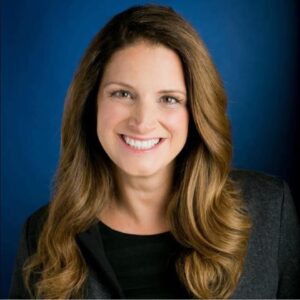Interviews with Stacy Lellos, Pam Bobowicz, and Karen Edwards
We’re so happy to have Stacy Lellos at the helm of Workman Children’s group. Here, Stacy discusses the vital work she does, her philosophy on children’s publishing, and what’s in store for the department.

Q: Stacy, could you tell us about how your background and experience inform your approach to leading the Children’s team?
SL: I’ve devoted my career to supporting children because I believe it is some of the most urgent, important work there is. I’ve had the incredible privilege to lead teams across publishing, marketing, and digital, culminating in my most recent role as President of Klutz. I’ve been wildly fortunate to have led the marketing for Harry Potter, Hunger Games, 39 Clues, Clifford, Klutz, and Toys “R” Us. I think my experiences working across so many facets of publishing and retail have honed my ability to think strategically about how to best bring books to life and help them find their intended audiences.
The Children’s publishing team at Workman is uniquely multifaceted in that we have both an educational team, expertly led by Karen Edwards, and a trade team, innovatively led by Pam Bobowicz. Though distinct, one informs the other. How do we educate and inspire children of all ages? How do we help kids understand themselves, others, and the universe around them? What can we publish that helps children live life with purpose and passion? Our superpower at Workman is finding the authors, illustrators, experts, talent, formats, facts, and stories that make these things real for our collective children. What a gift. I don’t take even one day of it for granted.
Q: What is your vision for the Children’s editorial department at Workman?
SL: I see Workman Children’s as publishers of books that help kids understand the world around them. It is both an incredible privilege and a huge responsibility that we take very seriously. What we don’t take too seriously is ourselves. We’re constantly thinking about how to make learning fun and engaging for kids.
Our founder, Peter Workman, gave a speech that is a master class in everything I love about publishing generally and Workman specifically. There is one line in that speech that I think about every day, “Know what you do as a publisher that no other publisher does, and do it better than anyone could. Try to publish books that are singular. Find the unique way to cover a subject. Give the book the format it needs, even if it’s never been done before. Be open to new ideas, and follow them wherever they lead.”
That is why I came to Workman. To publish books that are singular. To find unique ways to cover a subject. To give each and every book on our list the format it needs, even if it’s never been done before. And always, ALWAYS to be open to new ideas.

We also spoke to executive editors Pam Bobowicz (trade nonfiction) and Karen Edwards (educational) about the variety of books we publish at Workman Children’s and what kinds of proposals they find most exciting.
Q: Pam, can you explain the difference between a nonfiction children’s book for Workman versus other publishers?
PB: We look for books that take a topic or theme or author and turn it on its head. For example, when people talk about the Constitution for kids, they talk about the Bill of Rights or the Constitutional Convention. In The Constitution Decoded by Katie Kennedy, we pulled the whole text apart, translated it, illustrated it, and gave readers a thorough—and fun!—guide to the document that shapes our nation.
Our books try to make learning and education accessible and fun without losing any of the integrity of a book that discusses the facts, the truth, and the world around us. We’re looking for fresh ideas, new voices, unique life experiences, and art and text that allow us to think outside the box in terms of format—from Turn This Book Into a Beehive to The Bones Book and Skeleton, we love to meet with production to try the impossible! We want to publish nonfiction that looks our young readers in the eye and makes them feel seen, and helps them to be happy, engaged, curious readers who are active participants in the world around them. We aim to be the place that children, and the grown-ups in their lives, turn to when they have a question about the world.
Q: What immediately piques your interest in a proposal?
PB: A topic I haven’t read about before/in a long time, an engaging voice, a humorous approach to something serious so it feels accessible, art that feels fresh and exciting, an innovative format. . . . But the thing that stands out the most to me is an author who has thought about the young reader on the other side of the project. When I find an author or illustrator who understands how to reach their reader through their work—I will never stop talking about that proposal.

Q: Karen, what do you think makes an educational resource or series successful?
KE: Sound pedagogy, accessibility, engagement, and a touch of something different. When I look at Brain Quest and the Big Fat Notebooks, I see that their success is built on the foundation of those principles. Caregivers know—and trust—that Workman products will reinforce classroom curriculum. The advisory panel of teachers acts as an imprimatur for these series. Sound content can’t stand alone, though. Kids need to connect with the activities and have fun while working on the pages. They have to be able to see themselves reflected on the pages, and they need to be challenged by the content.
Q: What immediately piques your interest in a proposal?
KE: A proposal that features a fresh, engaging take on a traditional concept will always grab my attention. I ask myself these questions when I’m reviewing proposals: Will a child want to use this book? Will this book get a child excited about learning? How does it light a fire for that child who has convinced themselves that they’re not good at this subject or that the subject is boring? Is it educationally sound—would an educator or librarian consider it a valuable resource? I love to see writers address a diversity of learning styles and encourage children to engage with the book in different ways. And finally, a proposal that celebrates learning though humor, accessible language, engaging illustrations, and fun challenges. Proposals like these generally reflect a love of the learning process and a respect for the child—a great place to start with an educational product.
With such a dynamic, passionate team in place, there’s a lot of excitement to come in our Children’s department. To meet the rest of our team, please visit the Workman imprint webpage and scroll down to see our bios. To see our recent children’s titles, check out our Spring 2022 and Fall 2021 catalogs.





No Comments